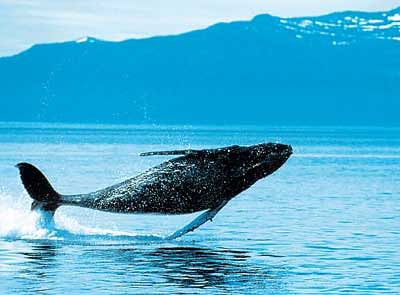
Biological oceanographer Andrew Pershing wants carbon credits for whale conservation. That’s because whales, he says, are like trees. “Like any animal or plant, they are made out of carbon. And whales are so big they each store a lot of carbon,” he says. Pershing, of the University of Maine in Orono and the Gulf of Maine Research Institute in Portland, calculates that even though some whale species are now recovering from the effects of factory whaling, total whale biomass today is less than one-fifth of what it was in 1900, before whaling decimated the population.
Letting the whale population recover, he remarked at the American Geophysical Union’s 2010 Ocean Sciences meeting in Portland, Oregon, could eventually sequester nine million tons of carbon in their combined biomass.
Much like planting trees
He compares it to planting trees. “In a forest, trees remove carbon dioxide from the atmosphere and accumulate that as biomass. Whales take carbon out of the system through their food, then incorporate that carbon in their tissues.”
Whaling, by contrast, is like cutting down trees for firewood. “You’re taking whales out of the population and putting their carbon somewhere else.” In the early days of whaling, Pershing explains that carbon was going straight into the atmosphere through the burning of whale oil in lamps, for example. More recently, he says, the carbon is released through the consumption of whale meat by humans, “but you’re still taking carbon out of the whale and putting it into something that’s going to respire it.”
When whales die naturally, they usually sink to the bottom of the ocean, carrying their carbon with them. Back in 1900, when whale numbers were high, that would have totalled about 200,000 tons of carbon per year, Pershing estimates. Even though benthic creatures eventually eat the whale carcasses, the carbon will remain in the depths, Pershing says, staying “out of the atmosphere for potentially hundreds of years.”
Carbon consumers
By comparison, nine million tons is only a small fraction of the seven billion tons of carbon entering the atmosphere each year from human activities, Pershing says, but it’s still a lot. It’s equivalent to 11,000 square kilometres of temperate forest, or 11,000 Hummers driving for 100 years, says Pershing. It’s also comparable to the amount of carbon involved in forest-management schemes being proposed for buying and selling carbon credits, he said. “People would pay a lot to preserve an area of forest that big.”
If whales increase in numbers, other species that compete for the same food might decline. But even if ocean food supplies are limited, there could still be a substantial increase in total biomass owing to the difference in size between whales and the organisms they could displace. Because large animals require less food per unit mass than smaller animals, any given food source (such as krill) can support a lot more biomass in a whale than in a small animal such as a penguin.
Rebuilding stocks
Other scientists greeted Pershing’s presentation with enthusiasm. “It’s exciting,” says Daniel Costa, a professor of ecology and evolutionary biology at the University of California, Santa Cruz. “It means that whales are important not just because they’re charismatic, but because they play an important role in the carbon cycle.”
Also, he says, Pershing’s research may actually understate the degree to which whales could sequester carbon.
The iron in whale faeces is an important micronutrient that is often in short supply in waters such as the Southern Ocean, and it can help boost algal growth which ultimately means more food for everything, including whales.
“In order to drive these large algal blooms you need iron,” says Costa. In fact, he says the indirect benefits of iron fertilisation from whale faeces might remove more carbon from the atmosphere by boosting algal growth than the growth of the whales themselves.